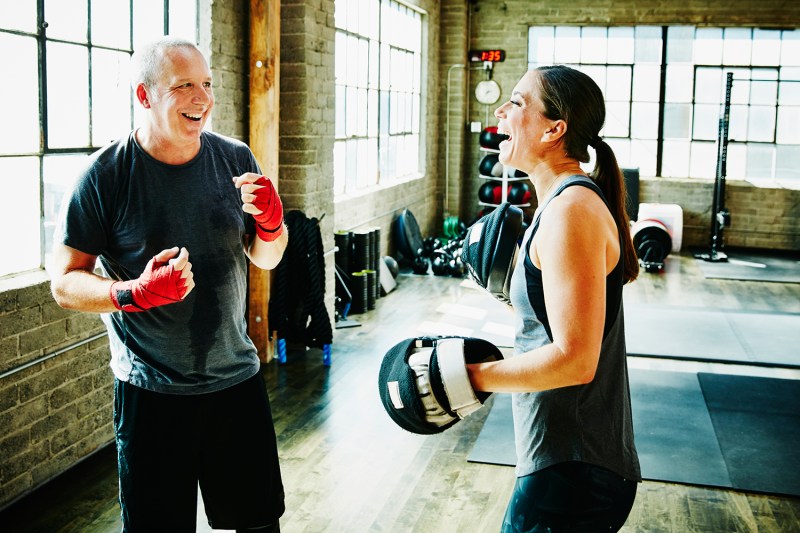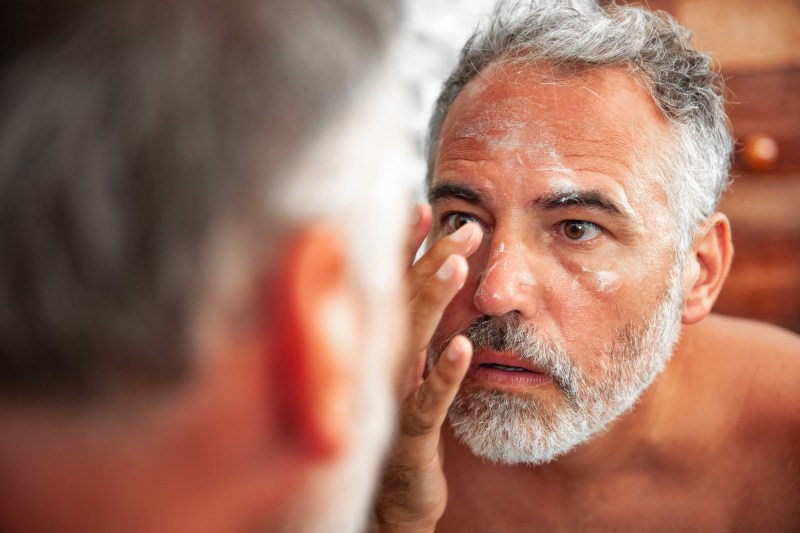
Many things change over time, including our bodies, our hobbies, and our preferences. Most likely, the things you are into when you were 22 are different than the things you are into when you are 52. At the very least, they are more evolved versions of the style you rocked in your youth.
That being said, no man should wear the same thing in his 20s as in his 50s. If you don't develop with age, you can quickly look and feel out of date and out of style. Dressing appropriately for your age is a talent that can sometimes feel overwhelming, but with these tips, you can master the skill of looking great at any age.
No guy wants to admit that he's getting older, but it's essential to be honest with yourself when shopping. Nothing is worse than a man in his 40s dressing like he is 20. He can come across as immature or even creepy, a man-child most people can't and won't take seriously.
While a 20-year-old dressing like he is 40 is better, it's only marginally better. He may be trying to look more mature, channeling that old soul, but he often looks like he borrows all his clothes from his father and doesn't know how to dress himself. There are five aspects to dress your age that will help you make the right choices.
- Evaluating your personal life.
- Evaluating your professional life.
- Dressing for your hobbies.
- Knowing your audience.
- Understanding how your body changes
Here are some tips to help you figure out how to do those things at every phase of your life.

Dress your age in your 20s
Your 20s are a time of discovery. You're out of the house, out of school, and out of your childhood. You no longer have to ask permission or get clearance from your parents on what to wear. When you walk out of the bedroom to head out the door, no parents tell you to turn around and put something else on. While there is an ultimate feeling of freedom, there is also an overwhelming responsibility as you build your image and reputation.
Step 1: Evaluate your personal life
When you are in your 20s, you are not only building your image, but you are also finding yourself in many different areas of life. You are building your social life and likely your circle of influence. Building a social circle typically involves more outings to bars, clubs, or nightlife.
Your style in these years will almost certainly be trendy and follow the latest looks. There is a perfect storm of trying to keep up with the latest trends while also making the least amount of money in your life that will cause you to need to look for cheaper items that look higher in quality. Focus on versatility with your items, things that go with more and can be re-worn without notice. This allows your clothing to go further.
These are the items you should always have:
- A pair of dark dress denim jeans
- A pair of clean, white sneakers
- A simple black collared button-up
- A pair of tan dress shoes
These won't always be worn together, but each one of them is versatile and will serve you well as you find your style.
Step 2: Evaluate your professional life
When you graduate college, your goal is to find a job and begin a career. That means learning new rules you've likely never had to consider. Not only do you have to learn a new set of rules, but every company also has different definitions for those rules. For instance, try and find two companies with the same description for "business casual."
The trick to dressing professionally in your 20s is to look up. Managers and supervisors respond to people they can see themselves in, so look at what they are wearing and emulate it. That doesn't mean copying them — far from it. But if everyone around you is wearing chinos and polo and the manager is wearing a suit, consider investing in a suit (or, at the very least, a sports coat).
At this point in life, you are just starting out, so check out the four-legged stool for ideas on what to focus on in your professional wardrobe.
Step 3: Dress for your hobbies
More discovery is on hand for you in your 20s, as you start to explore several new hobbies now that you are grown up with adult money. Whether your new job has taken you to far-off places that offer unique experiences or your new social circle exposes you to new ideas for outings, you will undoubtedly need threads for those hobbies.
Remember that versatility is key. So if you are looking for a new pair of pants for the hiking trail, make them more of an athletic chino that can also be acceptable for your first time on the golf course, something like these Kinetic pants from Ministry of Supply. Investing in hobby-specific items can be a money dump if you don't leave yourself the option of using them elsewhere. Of course, if you are snowboarding for the first time, there isn't much wiggle room in versatility.

Step 4: Know your audience
Your outward appearance is a reflection of your inner self-image. That means that no matter how you feel on the outside, your style will tell others what they can expect. Your friends will know if they can lean on you in tense situations, your co-workers will know if you are confident and dependable, and your potential mates will make their minds up about you almost immediately.
The trick to sending the right message to your friends is to dress as though you care. You don't always have to dress to the nines for your buddies, but if you are always the guy in basketball shorts and a T-shirt, it sends the message that you put as much care into hanging out with them as you do playing XBOX at 2 a.m.
Your co-workers and superiors will see you taking care of your appearance and begin to feel that you will take the same care with their company's image. Just because a suit isn't mandatory doesn't mean it isn't appreciated or recommended.
Step 5: Understand how your body changes
For most men, this is when you will be in the best shape of your life. Exercise and weight management only get more challenging as you get older, so take advantage of this time. The fit of your clothing is more important than the clothing itself. The best shirt or sharpest outfit will look worse than everything on the dance floor or in the office if it is ill-fitting.
Your shirts should accentuate your chest and arms by being fitted. Even if your arms aren't the size of Dwayne Johnson's, something that fits snuggly will make you look and feel like they can compete. The rest of the shirt should drape, not cling. If anything is too tight, it seems like a holdover from when your parents bought your clothes for you a decade earlier.

Dress your age in your 30s
You aren't old by any means, but you can't blame any shortcomings on being a kid anymore. You are beyond the wild days of your 20s and have narrowed your friend group to only those who align with your ideals and social preferences. You have likely chosen a partner, and your life is taking shape.
Your wardrobe is evolving from a kid trying to scrape by to a man finding his footing in the world. Upgrade and elevate.
Step 1: Evaluate your personal life
Your personal life may feel like it is starting to suffer under the weight of work and starting a family. Your friend group has thinned out, but you have selected your partner and are beginning a family life. This is the natural progression of selecting quality over quantity. You aren't losing friends; you're gaining deeper connections.
That said, your wardrobe should be going through the same transformation. Gone are the cheap attempts at trendy statements; they're being replaced by quality pieces you can wear throughout social gatherings. Even if they are fewer and further between, they will mean more, and you will feel them more profoundly.
Replace your graphic tees with high-quality fabrics or patterns. Focus on the fit to accentuate the body in the prime of life. Ditch the shorts and joggers unless you are headed to the gym, and dress as if you could meet someone important. Because you just might. And you should be wearing different shoes based on the occasion. There are seven shoes you should own by now to keep you covered for all moments.
Step 2: Evaluate your professional life
Now that you have learned the ins and outs of the office and what they expect from your dress code, it is time to make it your own. If you wear a suit daily, branch out from the grays and blues to browns and more natural tones. Invest in patterns and materials that make statements and express who you are.
If you don't wear a suit, invest in higher-quality garments that will last. This shouldn't be something you have to focus on or worry about enough to detract from your work. High-quality garments allow you to look good without worrying about whether they will last.
You don't have to spend thousands upon thousands at once, but you should be trading out your cheaper garments you bought in your 20s with higher-quality garments that will last until your 40s or beyond.
Step 3: Dress for your hobbies
You have presumably been promoted at least once at your job, so your hobbies can benefit from this. There is a high likelihood that you have chosen the hobbies you love and are dedicated to. You can upgrade your gear and clothing and spend a little more money.
One thing to remember as you upgrade your clothing for your hobbies is to maintain the separation of church and state. Your ability to narrow your focus on specific pursuits and afford higher quality will make you want to wear these garments all the time.
Ironically, this shortens their effectiveness and life span. Keep your basketball shoes on the court, hiking clothes on the trail, and golf pants and polos on the course.
Step 4: Know your audience
Your audience is three-sided in your 30s. In the professional realm, you have a weird mix of having the higher-ups still looking at you as a possible promotion prospect and the people following in your footsteps a decade younger than you. Knowing and understanding your place of employment's dress code and becoming a model of it appeases both.
In your world, men will follow each other. If one man in a group wears last decade's graphic tee and basketball shorts, others will see that as their cue to do the same. If you want to be the guy that others follow, ensure you ditch the younger attire and signify your maturation into a new level of manhood.

Step 5: Understand how your body changes
This is the second time in your life you will start to feel your body changing. While you may be in the prime of your life in your early 30s, physically, you will begin to feel yourself slow down by your late 30s. If you remain active, the difference will be slight, but everything you do will take a little more effort.
As you go through this decade, your suits will begin to fit differently, and the tailoring needed should reflect that. Going to the store and trying on new brands will become more critical as ordering online is riskier since you have to work much harder to keep your body in shape. As you shop in your late 30s, focus on fit and comfort more than price. The higher-end products don't necessarily mean the best fit.

Dress your age in your 40s
Here it is, your 40s. People will say that these are your "middle-aged" years. If your life were a week, you'd be on Wednesday. You are in a place where you have gained authority, life, work, and family; you are in charge. You are asking for less and providing more.
Your wardrobe will go through two significant changes; quality and fit. There is no reason to buy cheap any longer. You are in the prime money-making years of your life, and every article you purchase should be an investment. That doesn't mean you have to drop thousands of dollars if you want a suit or a watch. It simply means you no longer should indulge in impulse buys.
There are five items you should have at all times:
- Dark dress denim
- Light gray cardigan
- White sneakers
- Body trimmer
- Skincare routine
These will keep you looking sharp and younger without trying too hard.
Step 1: Evaluate your personal life
This is where many men lose themselves and their fashionable image. They succumb to the "dad looks." Jean shorts and white New Balance sneakers, mowing the lawn with a polo tucked in. You don't need to follow this pattern. There are some things you can do.
First, keep church and state in mind. By all means, if you like mowing the lawn in those things, do it. But keep those garments aside for those moments. Dedicated work shoes and chore clothes will keep your mindset away from dressing like a dad when you go out to dinner. And will protect those nice chinos from grass clippings
Second, many men resort to these looks because they fit a variety of body shapes and no longer recognize their bodies. You will likely gain some around the middle as you are too busy and tired to exercise at the same rate. You also have a higher stress level, contributing to weight gain. Invest in a tailor to help you find and create the fits you need. You will be surprised by what a tailor can do for you.
Step 2: Evaluate your professional life
You are at the highest level of value for your company by this point. You are energetic and efficient, a leader among your peers, and you have years in front of you, so you are worth the investment. You are no longer dressing for the people above you; you are dressing for those coming in behind you. You have elevated to the leadership role that makes you the man others are looking to be.
Since others are paying attention, keep most of what you wear down the middle. If you are too plain, your office can start to look like the headquarters for the Men In Black, but if you are too flashy, the people emulating you can get garish quickly and make your company look foolish.
Think about Presidents, CEOs, and others who lead. Most of them wear basics because they focus on quality and function. James Bond is another excellent example. He rarely wears flashy and mostly sticks to high-quality staples that will last him forever.
Step 3: Dress for your hobbies
You are at the highest level of experience in your hobbies. You have been doing them for 20 years now. Therefore, you know the best brands and the best products for you. Don't overthink this; if something has been working, allow them to continue working.
We can't stress the separation of church and state enough. There is a place for your hobbies and a place for the clothes that belong there. Keep the hiking clothes on the trail. And keep the denim shorts on the lawn mower.

Step 4: Know your audience
We tend to get comfortable as men wearing the same thing to every place we go because it is simple, easy, and comfortable. Remember that while some women love the dad bod and the dad look, they all love effort. And nothing says lack of effort like wearing the same things everywhere you go.
If you put thought into how you look when you go on dates with your partner (or when meeting with business clients), the people you meet automatically assume you will put the same thought into them.
Step 5: Understand how your body changes
This is typically when men see their bodies begin to soften. Their joints are weaker, the weight is harder to keep off, and more effort is needed to keep fit. Your wardrobe will find those similar struggles. The suit styles and cuts you always wore may fit differently than they did 20 years before. There is no shame in moving from a slim to an athletic fit. Or an athletic fit to a classic fit.
Knowing and accepting the changes in your body will help you continue to look good by wearing clothes fitting the physique you have now, not the one you miss from high-school football.

Dress your age in your 50s and beyond
You are now in the twilight years of your life. Don't worry; these years last almost as long as the rest of them combined. From 50 years old and on, your wardrobe and the etiquette around it will stay virtually the same. You will notice a few things as you move from decade to decade that will need your attention, but this time is mainly about comfort and enjoying the life you have spent 30 years building for yourself.
Step 1: Evaluate your personal life
You will find more value in the people around you than ever before. You've learned that no matter who you are or what you do, the people you share it with matter. You've taught your son how to dress himself and look his best. You've taught your children what to look for in a partner, and you have taught people that worked with you how to put their best foot forward.
You've moved into the mentor role of your life, and the clothes you get will reflect that. Simple staples of high-quality materials will help you stand out as a success. People notice quality. If you adorn yourself with subtle quality, it allows others to focus on the quality of your wisdom and experience as much as the quality of your attire.
Step 2: Evaluate your professional life
You are training your replacements. Let's be honest; you have spent your entire life building a career that has allowed you to afford hobbies, vacations, and a home full of joy. Now, you want the time to enjoy all that, but you can't just leave your life's work in the hands of anyone. You take the mentor role to heart at work, and the wardrobe matches.
Everyone looks to you. No one else can set an example of how to dress for success than someone who has lived and breathed it for decades. Your high-quality garments that are tailored to fit perfectly accentuate your strengths and keep all focus on the task at hand.

Step 3: Dress for your hobbies
You will likely have more time on your hands, which means if there is ever something you have even briefly thought about trying, now is the time. In your 20s, you bought cheap and versatile things because you needed to figure out what you would like or dislike.
After living with yourself for 5+ decades, you know what will be a hit with yourself. Don't worry about versatility. Buy whatever you want to enjoy this new experience. If it resonates less than you thought, there is always Facebook Marketplace.
Step 4: Know your audience
Simply put, your audience is everyone in your life. You are no longer one of the many faces of men trying to establish themselves. You are the man who proved himself, and others will look to you to teach them how to do the same.
These years are about comfort and timeless style. You will have discovered your favorite garments and shoes over the last several decades, and anything you purchase should fit those items.
Step 5: Understand how your body changes
You will see a lot of changes throughout these years. Your hair will lighten and thin, your skin will loosen, and it will feel like everything on your body experiences gravity a little more potently. There are tricks you can do to manage those things.
First off, embrace your grey. It is no longer a sign of old age; it is a sign of wisdom and perseverance. Brimmed hats like a fedora or Panama hat will play well if you want to cover it up. The skin around your neck will likely begin to sag as the elasticity wears down. Scarves are a stylish way to keep that under wraps if you become self-conscious. That doesn't just mean heavy scarves for winter. Silk scarves and ascots work similarly in the warmer months. But just in case, make sure you are keeping up with your skincare to make sure you extend its life with your own.
And finally, you will feel like you want to find ways to keep things nice and tight as you go daily. Other than staying active and fit, invest in compression garments like shirts, underwear, and sleeves. Many of these have the bonus of promoting blood flow and energy boosting.
Age is a number
Here is the caveat to everything you just read, age is a mental state. You should never feel constricted by your age. You can do anything and be anyone you want to be, there is nothing about your age that will stop you. The number you give people when they ask how old you are is nothing but a record of trips around the sun, and it has nothing to do with your mindset and your seal for life.
Just because you are in your 50s, doesn't mean you can't love and pursue the same things in your 20s, but the approach will be different. Take care of your body and your body will take care of you. Begin every day with the mindset that you can do anything you set your mind to, no matter what you decide that is.
Aging isn't a bad thing. It means we woke up today. While it is easy to feel nostalgia for the past, it is more fun to think about the possibility of the future. Your wardrobe will be a constant companion, going along with you every step of the way. As we said, your outward appearance reflects your inner self-image. That said, if you are in your 40s and dressed like you are in your 20s, or vice versa, your clothing can express the confusion you are likely experiencing in your life.
Embrace your age, embrace the pros that go along with each stage, and dismiss the cons. Like everything in life, the pros outweigh the cons every step of the way because the biggest pro is that you are still here.
Frequently asked questions
How do I style myself to look older?
For a man to style himself to look older, he often needs to distance himself from his peers. That can look like dropping the graphic tees or going for a crew cut when the rest of the gang is sporting the stereotypical zoomer broccoli cut. If you're in your early 20s and your beard isn't fully developed yet, go ahead and shave versus letting it be wispy. Finally, it is common to buy and be gifted slightly oversized clothing in your childhood, so you can grow into it. Even though you've stopped growing, it can be tempting to buy new clothes that feel slightly big, but you should avoid this urge.
What clothes make you look more mature?
If properly fitted, formal attire can make you look more mature. It doesn't need to be fancy or flashy, either. A simple collared shirt, tie, pleated pants, and a pair of nice shoes will tell the world you are doing something important and working on your career. Even if you have a boyish face, people will know you have a grown man's heart.
How do you stay stylish as you age?
For men, staying stylish through the years is all about getting back to classics. New trends and flashy colors that might draw eyes and attract a fun level of attention on the youth are likely to look silly and clownish on an older man. Stick with properly fitting attire, good posture, and the confidence that comes with age to win in this aspect of style.



